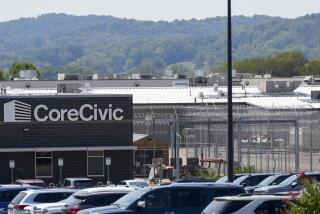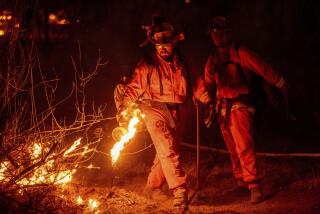It’s a workaday world for N. Carolina inmates : Governor’s community labor program, thriving farms give prisoners a chance to learn skills and repay a debt to society.
TILLERY, N.C. — As the morning wind blew across the vast Caledonia Farm, men bent over makeshift tables, potting day lilies. Dressed in jackets, caps and gloves, each wore a bright orange vest with inmate printed across the back.
Although some complained, no slackers are permitted. For that would mean a return to the Caledonia Correctional Institution to spend the day in lockup.
These inmates and others across the state are participating in North Carolina’s prison-work program, one of the nation’s most progressive. They are fulfilling Gov. James B. Hunt Jr.’s 1992 campaign pledge to put inmates to work. And in stark contrast to the chain gangs cropping up in other states, North Carolina prisoners work at jobs that benefit the system and communities.
“Work gives inmates some hope and a sense of self-worth. In the process, they are benefiting the state and paying their debt to society,” said Franklin Freeman, secretary of the state’s Department of Correction.
The latest innovation in the Governor’s Community Work Program premiered Nov. 1--a toll-free hot line to invite ideas for public works projects for city, county or state properties.
“The [hot-line] program is an opportunity for persons in correctional institutions across the state to be good neighbors to others in the community,” said Keith Hester, head of inmate work programs.
There is no charge for the inmate labor. A maximum of 10 days is allotted each job, but workers can return later to complete the project. Inmates earn from 40 cents to $1 a day and receive time off their sentences for every day worked.
The governor’s work program, which has been fully in place since Jan. 1, saves taxpayer money that would have gone to private contractors and gives communities the chance to complete projects that languished because of lack of funds.
These include clearing tire dumps that had harbored mosquitoes and snakes, chopping away underbrush in a state park so that the endangered red-cockaded woodpeckers could return to their nesting places and excavating earthen drainage ditches around a state-owned historic home. Because of the delicate walls of the ditches, no heavy equipment could be brought in, and the inmates had to resort to digging with spoons in some areas.
Of the 27,000 inmates in North Carolina, more than 17,000 are working or are in some type of work training.
At Caledonia Farm--a 7,500-acre, state-owned property 120 miles northeast of Raleigh--inmates have tilled the soil for almost a century.
Last year, their labors saved the Correction Department $5.2 million. The produce grown on the farm and the products preserved in the cannery account for one-third of all state prison food. Last year’s cotton and peanuts grossed more than $750,000, and $880,000 was realized from cattle and poultry sales.
Profits are reinvested in inmate salaries, farm equipment and other needs. Any excess is returned to the state treasury.
While some states have phased out their work farms, the two in North Carolina are so successful that two more, housing 500 men each, are under construction.
On Caledonia Farm, there are maximum-security inmates who work under the watchful eyes of shotgun-toting guards.
The minimum-security inmates have no armed guards and perform jobs that require less supervision. They work in the poultry houses, tending the hens and gathering, sorting and packing eggs. Some manage the livestock, and during the winter they spend hours on horseback tending the newborn calves. A few are taught to operate the heavy equipment--ditch-diggers, road-graders and cotton-pickers.
Because of the size and remoteness of the farm, prisoners rarely attempt escape.
Along one of the many roads that crisscross the farm, a crew of maximum-security inmates recently chopped away at brush.
Michael Player, 22, who is serving 14 years for breaking-and-entering and drug possession, said he had no problem with the farm work. “That way society can’t say I’m staying here free. They can’t say I came here and laid around.
Ronnie Sawyer, 35, pointed to the long road of brush that lay ahead for him and his group. Serving a sentence of natural life plus 13 years for kidnaping and rape, Sawyer said that work on the farm helps him cope with the long days of prison life. “A lot of guys think of this as hard labor, but I think of it as freedom. Being out here gives me solitude. When you do this work, you can get tired, and you go back in at night and go to sleep,” he explained.
In one of the farm’s henhouses, minimum-security inmate Major Ward, 44, serving time for second-degree murder, tends 4,000 chickens and counts the days until his possible parole in 1998. Ward said he returns to his cell each night and draws plans for the chicken farm he intends to build some day.
“Since I’ve been here I’ve finished my college degree . . . learned to be a mechanic, a brick mason and a carpenter. I’ve learned a lot of trades, but chickens is where I want to go to,” Ward said. “I’m here to get some type of rehabilitation for the crime I committed. When I came in I said to myself, ‘I’m here, and I might as well make the best of it.’ ”
More to Read
Sign up for Essential California
The most important California stories and recommendations in your inbox every morning.
You may occasionally receive promotional content from the Los Angeles Times.










